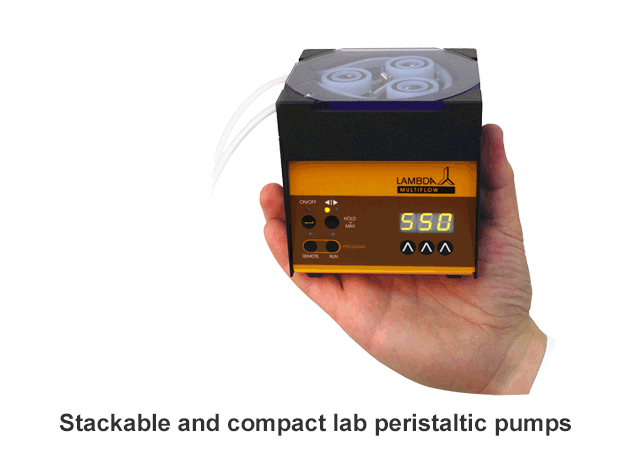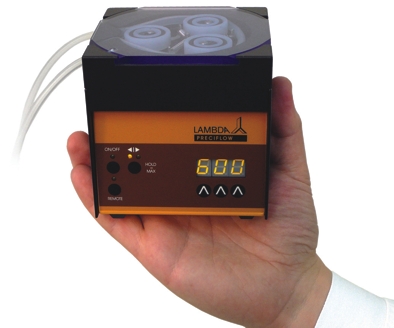Protein purification: Liquid chromatography & gradient elution
with OMNICOLL fraction collector and LAMBDA peristaltic pumps
For protein purification and isolation of peptides, nucleic acids or small molecules from the crude mixture of fermentation broth, liquid column chromatography (LC) is widely used with ion exchange, hydrophobic interaction, affinity or size exclusion in downstream processing (DSP).
In order to optimize the liquid chromatography processes, the OMNICOLL fraction collector and reliable LAMBDA peristaltic liquid pumps are successfully used in laboratory practice:
Example setup of automatic fraction collection
For example, a complete arrangement of column chromatography with automatic collection of eluate using OMNICOLL fraction collector includes:

- Two similar containers with elution buffer A & B connected by a siphon (or tube at the bottom with a valve to adjust the flow)
- Elution buffer A is consistently drawn into the beaker with elution buffer B which is constantly mixed by magnetic stirrer, thereby altering its buffer concentration
- Programmable LAMBDA peristaltic pump to pump the gradient mixture into the column
- Eluate from the column is being passed through the detector (to measure pH, Absorbance 280 nm, conductance)
- From the detector, the protein fractionation is collected by the OMNICOLL fraction collector into the desired containers (e.g.: tubes, vials, etc.)
The proteins are eluted by changing the composition of the buffer (ionic strength, pH, conductivity, concentration of salts, etc.). The elution conditions can be changed from linear, stepwise or segmented stepwise by changing the flow of buffer A to B in which the mobile phase composition changes over the time.
Procedure
In the liquid column chromatography, it is important to pack the column evenly without air bubbles, channels, and cracks on the stationary phase.
The LAMBDA peristaltic pump supplies the liquid mobile phase continuously to the packed chromatography column at a consistent pulsation-free reproducible flow rate.
The sample mixture loaded on top of the chromatographic column is separated by passing through the solid stationary phase (resin):
The constituents of the fermentation broth are adsorbed and desorbed at a different extent on the stationary phase, whereas the components in the mobile phase slowly separate from one another.
As the mobile phase continues to flow through the column, the column effluent or eluate, are collected in fractions at the lower end of the chromatographic column with the help of the OMNICOLL fraction collector .
A detector to continuously monitor protein elution from the column or the analysis of the fractions gives information about the concentration of the desired protein in fraction for further processing, for example: by gel electrophoresis.
Optimization of elution methods for protein purification
Choosing the right elution buffer, in liquid chromatography for enzyme purification, can considerably improve the quality of the separation and the analysis time.
Isocratic elution in liquid column chromatography
In liquid chromatography, the proteins are separated under constant solvent composition (i.e. isocratic elution):
- When samples are not very complex and also, when the sample components do not have similar retention times.
Besides, for the most tightly adsorbed proteins, the elution with constant mobile-phase composition will take very long time to be eluted.
Buffer and peristaltic pump are used for isocratic elution.
Gradient elution - for purification of proteins from complex mixtures (biological samples)
In gradient elution, the composition of the mobile phase changes during the separation process and it influences the retention of analytes.
The gradient elution is advantageously used in protein purification:
- Complex biological samples
- Mixtures with known properties
- Components with similar retention times
If gradient elution is used in liquid column chromatography for the purification of proteins, then the retention time can be shortened.
Gradient elution is carried out with two buffers and one or two peristaltic pumps.
Gradient elution and elution profile
Gradient elution implies that the mobile-phase composition will be varied during sample separation for optimum separation in minimum time.
With the different composition of the eluent (gradient elution), the retention factor and thus, the capacity factor could be influenced.
The gradient profiles:



Linear gradients are generally preferred; it can be implemented in linear, segmented, convex, and concave shapes. The non-linear gradients offer several distinct advantages, including reduced separation time, improved sample resolution, and higher detection sensitivity.

Biochemists recommend LAMBDA peristaltic liquid pumps which guarantee pulsation-free application of the mobile phase
Gradient generation with reliable peristaltic pumps
LAMBDA lab peristaltic pumps are programmable and remote controllable to achieve linear, stepwise and segmented gradient elution.
Gradient elution with one pump
Gradient elution can also be carried out with one peristaltic pump: the containers with elution buffer A & B are connected by a siphon or tube at the bottom with a valve to adjust the flow
-
Elution buffer A is consistently drawn into the well-stirred beaker with elution buffer B, where the buffer concentration being altered
-
Programmable LAMBDA peristaltic pump used to pump the gradient mixture into the chromatography column
-
The eluate from the column passed through the detector to measure pH, Absorbance 280 nm & conductance
-
From the detector, the eluate fractionation collected by the OMNICOLL fraction collector into the desired containers (e.g.: bottles, beakers, tubes, vials, etc.)
Gradient elution with two pumps
Two programmable LAMBDA peristaltic pumps are used for reproducible mixing of the eluents for gradient elution.
-
The change in the composition over time can be programmed directly on the LAMBDA peristaltic pump display or it can be recorded and displayed as a real-time graph using the PNet PC control software.
-
The gradient mixture passes through the chromatography column and the components are separated.
-
The eluate from the column passed through the detector to measure the pH, absorption 280 nm and conductance.
-
Automated fraction collector LAMBDA OMNICOLL, fractionates the eluate and collects the fractions based on the programmed time or drop counter.
Requirements of the pumping system for column chromatography
The most important requirements of the pumping system for column chromatography are:
-
Constant and reproducible flow rate
The reproducibility depends on the retention times of the peaks. The retention times are dependent on the flow rate. -
Pulsation-free flow
The stationary phase has to be protected against pressure surges. The baseline of the detector should remain stable.
LAMBDA MULTIFLOW programmable peristaltic pumps, which come with a 5 years warranty, are recommended to achieve reproducible flow rates.

Requirements of the fraction for protein purification
The most important requirements of the fraction collector for liquid column chromatography are:
-
Unrestricted capacity
The possibility to collect unlimited number of fractions is extremely important, especially during process optimization. -
Different volume range
To be able to adapt the fraction collector for various laboratory experiments and pilot scale processes.
The customizable fraction collector OMNICOLL is ideal for efficient process optimization in the laboratory and pilot scale.
